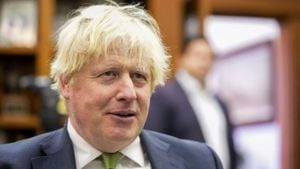The issue of terrorism remains at the forefront of national security discussions, especially as recent reports highlight significant findings concerning individuals attempting to enter the United States from Canada. An alarming statistic is gaining attention: approximately 87% of terror suspects intercepted at U.S. borders during the past year came from north of the border.
According to data from the National Post, the U.S. Customs and Border Protection (CBP) revealed startling numbers: out of 358 terror suspects identified trying to cross from Canada, only 52 were stopped coming from Mexico. This raises serious concerns about the nature of security issues at the Canadian border, overshadowed by the more commonly discussed challenges at the southern U.S-Mexico border.
The term “terror suspect” refers to individuals flagged on the American Terrorist Screening Dataset (TSDS), which includes people facing legal challenges related to terrorism, confirmed affiliates of terrorist organizations, and those with familial ties to such individuals. It’s important to note, as indicated by the National Post, just because someone is on this watchlist does not necessarily mean they are terrorists. The focus here is exclusively on those who attempted to enter the U.S. legally, not the many more who might evade detection.
Historical comparisons show this trend isn't new but rather part of an upward pattern. For example, the percentage of terror suspects from Canada has steadily increased from 82% of the 380 suspects stopped at U.S. borders in 2022 to 86% of the 564 suspects recorded in 2023. This consistent figure highlights not just isolated incidents but potentially systemic issues within border control enforcement.
The statistics arrive amid increasing scrutiny from U.S. lawmakers who are considering various border security measures. The border situation complicates discussions around immigration policies, as President-elect Donald Trump has recently suggested imposing tariffs on goods entering from both Canada and Mexico if these nations do not intensify their efforts against illegal immigration and transnational crime.
"It is imperative for these countries to actively participate in preventing the influx of drugs and unauthorized individuals across their borders," Trump stated, reinforcing the perception of the northern border as less secure compared to its southern counterpart.
Despite the gravity of the situation, Canadian Prime Minister Justin Trudeau's response has been relatively muted. Reports indicate he expressed optimism following discussions with Trump but has faced backlash for his perceived nonchalance. Critics from various political backgrounds, including Pierre Poilievre, the leader of the Conservative Party, have accused him of lacking urgency as concerns mount over the high number of potential terrorist entries from Canada.
Poilievre criticized the prime minister for not having a clear strategy to deal with what he calls "mass migration issues," indicating there are significant challenges stemming from the large population of individuals currently residing illegally within Canada. His remarks echo broader anxieties among the Canadian populace about national security and the effectiveness of current immigration policies.
While Trudeau acknowledged issues related to immigration, he contended there were systemic factors at play, emphasizing the requirement for reform among educational institutions. His government had previously acknowledged shortcomings surrounding how international students were integrated, misusing educational pathways as avenues for immigration without proper oversight.
Further complicate the narrative, border patrol agents have also reported unprecedented surges of individuals attempting illegal crossing from Canada. Erik Lavallee, the Border Patrol Agent-in-Charge for Vermont's Beecher Falls Station, noted, "It was a flood we had not seen before. It was an exponential shift." He pointed out how identified transnational criminal organizations are encouraging illegal crossings.
The statistics for the current fiscal year reflect this dramatic rise: around 19,000 people have been arrested trying to cross illegally, which is startlingly close to the total for the past 17 years combined. Although the latest data shows some reductions since the peak of crossings earlier this year, the recent figures still indicate troubling trends.
With U.S. infiltrations attributed to external pressures and criminal gangs, the Canadian government faces complex pressures concerning its immigration policy and border security measures. This aligns closely with Trump’s threats of tariffs as part of his administration's potential course of action, putting pressure on Trudeau’s government to devise solutions swiftly.
Despite the statistics presented, it's pivotal to recognize the nature of the TSDS; the data consists not just of individuals confirmed to be terrorists but also those connected to them, complicate the public's perception of what constitutes terrorism. This expansive definition has led to increased scrutiny of individuals who may be incorrectly identified as threats, which adds to the challenging balance of securing borders without infringing on rights.
At the core, the complexity of border control is on display, and it raises urgent questions about how to balance effective immigration procedures with national security needs. The increasing trend of terror suspects from Canada has sparked debate and raised concerns about captured identities and broader issues related to transnational crime, human trafficking, and resource management along the border.
Looking forward, Canadian officials and U.S. counterparts will need to navigate these challenges carefully. The pressure from U.S. lawmakers and the sentiment reflected by Trump could compel Canada to take more assertive action against terrorism and border security, leading to potential policy shifts moving forward.
Overall, as this situation evolves, the relationship between national security and immigration policies will continue to be at the forefront. Both countries must engage with these pressing issues thoughtfully to maintain community safety without compromising citizens’ rights or neglecting humanitarian avenues within immigration systems.



